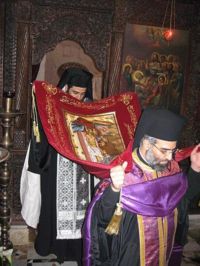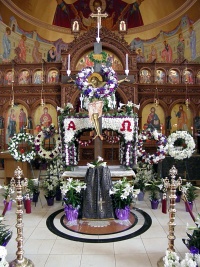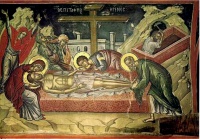Epitaphios

The Epitaphios (Greek: Επιτάφιος, epitaphios, or Επιτάφιον, epitaphion; Slavonic: Плащаница, plashchanitsa; Arabic: نعش, naash) is an icon, today most often found as a large cloth, embroidered and often richly adorned, which is used during the services of Great Friday and Holy Saturday . It also exists in painted or mosaic form, on walls or panels.
Contents
Iconography
The icon depicts Christ after he has been removed from the cross, lying supine, as his body is being prepared for burial. The scene is taken from the Gospel of St. John 19:38-42. Shown around him, and mourning his death, may be his mother (the Theotokos; John the beloved disciple; Joseph of Arimathea; and Mary Magdalene, as well as angels. Nicodemus and others may also be depicted. Sometimes, the body of Christ appears alone, except for angels, as if lying in state.[1] The oldest surviving embroidered icon, of about 1200 (Venice) is in this form. The equivalent subjects in the West are called the "Anointing of Christ's body", or Lamentation (with a group present), or the Pietà, with just Christ held by Mary.
Usually, the troparion of the day is embroidered around the edges of the icon:
- The Noble Joseph, taking Thy most pure body down from the Tree and having wrapped it in pure linen and spices, laid it in a new tomb.
In the Late Byzantine period, it was commonly painted below a Christ Pantocrator on the apse of the prothesis of churches, illustrating a liturgical hymn which celebrated Christ "On the throne above and in the tomb below".[1] The icon, in particular a panel mosaic version taken to Rome, probably in the 12th century, developed in the West into the Man of Sorrows subject, which was enormously popular in the Late Middle Ages, though this shows a live Christ, normally with eyes open.
Liturgical use
The Epitaphios is used on the last two days of Holy Week in the Byzantine rite, as part of the ceremonies marking the death and resurrection of Christ. It is then placed on the Holy Table, where it remains throughout the Paschal season.
Vespers on Good Friday

The Deposition from the Cross. Prior to the Apokathelosis (lit. "taking-down from the tree") Vespers on the afternoon of Great Friday, the priest and deacon will place the Epitaphios on the Holy Table. The priest may also anoint the Epitaphios with perfumed oil. A chalice veil and the Gospel Book is placed on top of the Epitaphios. This may be either the large Gospel Book used at the Divine Liturgy, or it may be a small one.
During the reading of the Gospel lesson (compiled from selections of all four Gospels) which recounts the death of Christ, an icon depicting the soma (corpus) of Christ is taken down from a cross which has been set up in the middle of the church. The soma is wrapped in a white cloth and taken into the sanctuary.
Near the end of the service, the priest and deacon, accompanied by acolytes with candles and incense, bring the Epitaphios in procession from the Holy Table into the center of the church and place it on a table which is often richly decorated for that purpose. [2] The Gospel Book is laid on top of the epitaphios. In some Greek churches, an elaborately carved canopy stands over the Epitaphios. This bier (Kouvouklion, catafalque) represents the Tomb of Christ. The Tomb is often sprinkled with flower petals and rosewater, decorated with candles, [3] and ceremonially censed as a mark of respect. The bells of the church are tolled, and in traditionally Orthodox countries, flags are lowered to half-mast. Then the priest and faithful venerate the Epitaphios as the choir chants hymns. In Slavic churches, the service of Compline will be served next, during which a special Canon will be chanted which recalls the lamentations of the Theotokos.
The faithful continue to visit the tomb and venerate the Epitaphios throughout the afternoon and evening, until Matins -- which is usually served in the evening during Holy Week, so that the largest number of people can attend. The form which the veneration of the epitaphios takes will vary between ethnic traditions. Some will make three prostrations, then kiss the image of Christ on the Epitaphios and the Gospel Book, and then make three more prostrations. Sometimes, the faithful will crawl under the table on which the Epitaphios has been placed, as though entering into death with Christ. Others may simply light a candle and/or say a short prayer with bowed head.
The priest may hear confessions at the Epitaphios, and he may anoint people who were not able to be present for the Holy Unction service earlier in the week.
Matins on Holy Saturday
The Burial of Christ. During Matins, Lamentations (Greek: Επιτάφιος Θρήνος, epitaphios thrênos, lit. "winding-sheet lamentation"; or Εγκομια, enkomia, "praises") are sung before the Epitaphios as at the tomb of Christ, while all hold lighted candles. The verses of these Lamentations are interspersed between the verses of Psalm 118 (the chanting of this psalm forms a major part of the Orthodox funeral service). The psalm is divided into three sections, called stases. At the beginning of each stasis, the priest or deacon will perform a censing. At the third and final stasis, the priest will sprinkle rosewater on the Epitaphios and the congregation, symbolizing the anointing of Christ's body with spices.
Near the end of Matins, during the Great Doxology, a solemn procession with the Epitaphios is held, with bells ringing the funeral toll, commemorating the burial procession of Christ. In Slavic churches, the Epitaphios alone is carried in procession with candles and incense.[4] It may be carried by hand or raised up on poles like a canopy. Many Greek churches, however, will carry the entire bier, with its carved canopy attached.[5] In societies where Byzantine Christianity is traditional, the processions may take extremely long routes through the streets, [6] with processions from different parishes joining together in a central location. Where this is not possible, the procession goes three times around the outside of the church building. The procession is accompanied by the singing of the Trisagion, typically in a melodic form used at funerals. Those unable to attend the church service will often come out to balconies where the procession passes, holding lit candles and sometimes hand-held censers. In many Greek villages the Epitaphios is also paraded in the cemetery, among the graves, as a covenant of eternal life to those who have passed away.
At the end of the procession, the Epitaphios is brought back to the church. Sometimes, after the clergy carry the Epitaphios in, they will stop just inside the entrance to the church, and hold the Epitaphios above the door, so that all who enter the church will pass under it (symbolically entering into the grave with Christ) and then kiss the Gospel Book. In Greek churches, the Epitaphios is then brought directly to the sanctuary, where it remains on the Holy Table until Ascension Thursday. In Slavic churches, it is brought back to the catafalque in the middle of the church (and honored further with more petals, rosewater and incense), where it remains until the Midnight Office at the Paschal Vigil on Great Saturday night. Where the Epitaphios remains in the center of the church, the faithful will continue to venerate it throughout Great Saturday.
Liturgy on Holy Saturday
The Hours on Holy Saturday will be read near the Epitaphios, and certain portions of the Liturgy that would normally be done at the Holy Doors (Litanies, reading the Gospel, the Great Entrance, etc.) are instead done in front of the Epitaphios.
Paschal Vigil
In the Slavic use, during the Midnight Office, after the Opening and Psalm 50, the Canon of Great Saturday is chanted (repeated from the Matins service the night before) as a reflection upon the meaning of Christ’s death and His Harrowing of Hell. During the last Ode of the Canon, at the words, "weep not for me, O Mother, for I shall arise...", the priest and deacon dramatically raise the Epitaphios (which represents the dead body of Christ) from the bier and carry it into the sanctuary, laying it upon the Holy Table, where it will remain throughout the Paschal season as a reminder of the burial cloth left in the empty tomb (John 20:5).
Paschal season
During Bright Week (Easter Week), the Royal Doors of the sanctuary remain open as a symbol of the empty tomb of Christ. The Epitaphios is clearly visible through the open doors, and thus symbolizes the winding sheet left in the tomb after the resurrection.
At the end of Bright Week, the Holy Doors are closed, but the Epitaphios remains on the Holy Table for 40 days, as a reminder of Jesus' physical appearances to his disciples from the time of his Resurrection until his Ascension into heaven.
Epitaphios of the Theotokos
An Epitaphios of the Theotokos also exists. This too is a richly embroidered cloth icon, but depicting instead the body of the Theotokos lying in state. [7] This is used on the feast of the Dormition of the Theotokos on 15 August, known in the West as the Assumption of the Blessed Virgin Mary. The Epitaphios of the Theotokos is used with corresponding hymns of lamentation, placed on a bier, [8] and carried in procession in the same way as the Epitaphios of Christ, although it is never placed on the Holy Table.
The Rite of the "Burial of the Theotokos" began in Jerusalem, and from there it was carried to Russia, where it was used in the Uspensky (Dormition) cathedral in Moscow. Its use has slowly spread among the Russian Orthodox, though it is not by any means a standard service in all parishes, or even most cathedrals or monasteries. In Jerusalem, the service is chanted during the All-Night Vigil of the Dormition. In some Russian churches and monasteries, it is served on the third day after Dormition.
Notes
- ↑ G Schiller, Iconography of Christian Art, Vol. II,1972 (English trans from German), Lund Humphries, London, p.199, ISBN 853313245
Source
See also
External links
- The Epitaphion translated from the French by O. Dunlop from The Orthodox Messenger (GOAA)
- Orthodoxy in Korea: Epitaphios photograph of an epitaphios in use
- Epitaphios icon by the hand of Nicholas Papas, at Come and See Icons
- Great Friday Epitaphios - an example of an epitaphios for sale


